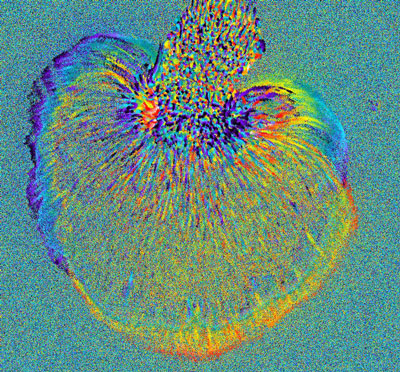| Posted: November 15, 2009 |
Cross-country runabouts - immune cells on the move |
|
(Nanowerk News) In order to effectively fight pathogens, even at remote areas of the human body, immune cells have to move quickly and in a flexible manner. Scientists from the Max Planck Institute (MPI) of Biochemistry in Martinsried near Munich, Germany, have now deciphered the mechanism that illustrates how these mobile cells move on diverse surfaces.
|
|
"Similar to a car, these cells have an engine, a clutch and wheels which provide the necessary friction," explains Michael Sixt, a research group leader at the MPI of Biochemistry. The results, which were developed in cooperation with colleagues from the MPI for Metals Research in Stuttgart, Germany, have now been published in Nature Cell Biology.
|
 |
| An immune cell paves its way and thus, forming finger-like extensions. Marked in colour is the skeleton of the cell. (Foto: Michael Sixt, Copyright: Max Planck Institute of Biochemistry)
|
|
White blood cells, also called leukocytes or immune cells, fight infections in the human body in many different ways. As defence cells, they are able to invade infected tissues, detect and eliminate pathogens. Also foreign structures and wreckage of the body's own cells are disposed with their help. To cope with that task, they move a hundred fold faster than other cell types. Thereby, immune cells follow certain attractants which are released by the body's own cells or the pathogens.
|
|
Energy Transfer on a Molecular Level
|
|
Cells have to generate the necessary energy from the inside in order to move forward. This task is carried out by the cytoskeleton, a network of proteins which stretches through the cell's complete interior. It can expand and form finger-like extensions and retract them likewise.
|
|
However, this deformation is not enough to make a cell move. "Similar to a car, the energy has to be transferred on the street," illuminates Dr. Sixt. "We need a clutch and wheels." For this purpose, every cell carries special cell anchors on their surface: the integrins. These proteins span the envelope of the cells and are directly connected to the cell's cytoskeleton. On the outside, these anchors can stick to other cells and tissues and thus, form a connection to the outside world. "The connection between the cytoskeleton and the integrin matches the clutch," says Dr. Sixt, "the connection between the integrin and the outside world corresponds to the grasp of the wheels."
|
|
Immune Cells are Cross-Country
|
|
In doing so, immune cells are not rigid and inflexible. According to the scientists, they are able to adjust to every possible underground. "Our analysis has shown that leukocytes always move with the same speed - no matter whether they migrate over a slippery or rough substrate," Dr. Sixt points out. That is possible due to the tight interaction between motor, clutch and wheels. When the cell's anchors do not grip properly, the cell increases the speed of its engine - the cytoskeleton deforms faster. Thus, the speed of the cell stays the same. Leukocytes are also able to overcome locally occurring unevenness. Should the immune cell move with one half over slippery and with the other on rough ground, the cytoskeleton adjusts locally - similar to a differential gear. "Thus, the direction of movement is defined only by the attractant," explains the physician. "And this attractant is just as little keeping with tissue frontiers and unevenness like the leukocyte."
|
|
Original Publication
|
|
J. Renkawitz, K. Schumann, M. Weber, T. Lämmermann, H. Pflicke, M. Piel, J. Polleux, J. P. Spatz, M. Sixt: Adaptive force transmission in amoeboid cell migration. Nature Cell Biology, November 15, 2009.
|

